“Let That Be Your Last Battlefield”
Written by Lee Cronin and Oliver Crawford
Directed by Jud Taylor
Season 3, Episode 15
Production episode 60043-70
Original air date: January 10, 1969
Stardate: 5730.2
Captain’s log. The Enterprise is en route to Ariannus to decontaminate the world, which is being overrun by a bacterial infection. Sulu picks up a Starfleet shuttlecraft flying on an erratic course—it matches the configuration of the shuttle stolen from Starbase 4 two weeks ago.
The shuttle is damaged, and the sole occupant isn’t responding, so Kirk has Sulu tractor the shuttle into the bay, then he, Spock, and a security team go to the bay to find a humanoid named Lokai, whose skin pigmentation is black on the left side and white on the right. He collapses and is brought to sickbay.
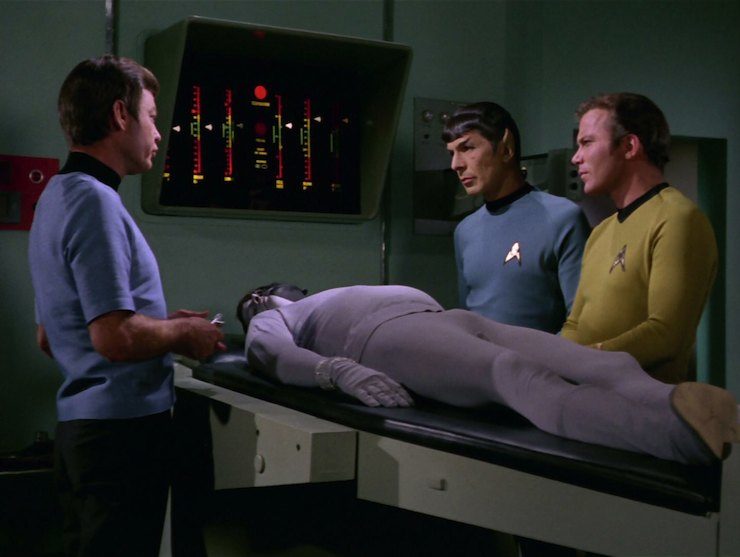
Lokai awakens, insisting his need for the shuttle made it necessary for him to make use of it. He resents Kirk’s accusations of thievery, though he is grateful for the rescue. However, he refuses to answer any further questions. Kirk intends to drop him off at Starbase 4 as soon as they’re done at Ariannus.
Chekov reports another ship, but it’s invisible, as there isn’t money in the budget for a new alien ship. The ship is built for speed, apparently, and it makes a kamikaze run at the Enterprise and disintegrates against the shields—but before it does so, it deposits another person similar to Lokai on the bridge. His name is Bele,and his skin is black on the right side and white on the left.
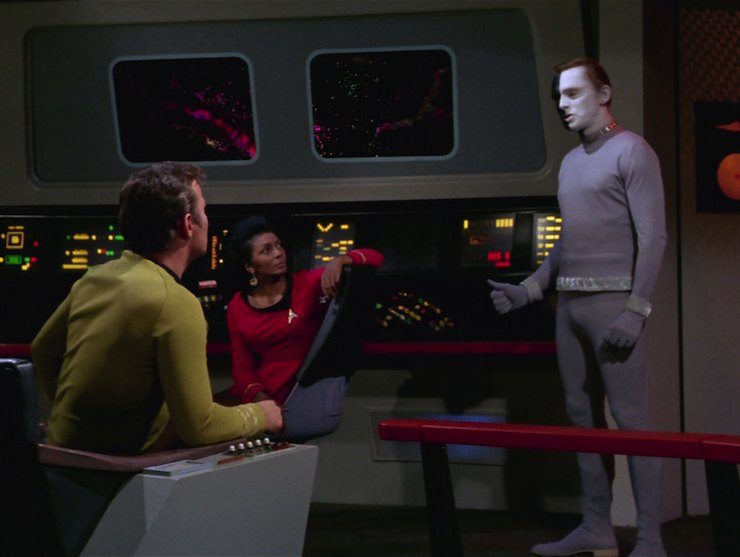
Bele is an officer of the law on Cheron, and he’s after Lokai. He wishes to take Lokai into custody, but Kirk isn’t quite ready to turn him over yet. Kirk and Spock do escort Bele to sickbay, where McCoy is tending to Lokai.
Lokai is a political prisoner: he is an agitator who is fighting for rights for his people—the folks with black skin on their left side—after millennia of oppression by Bele’s people. They obviously despise each other, and Kirk has to keep them physically separated.
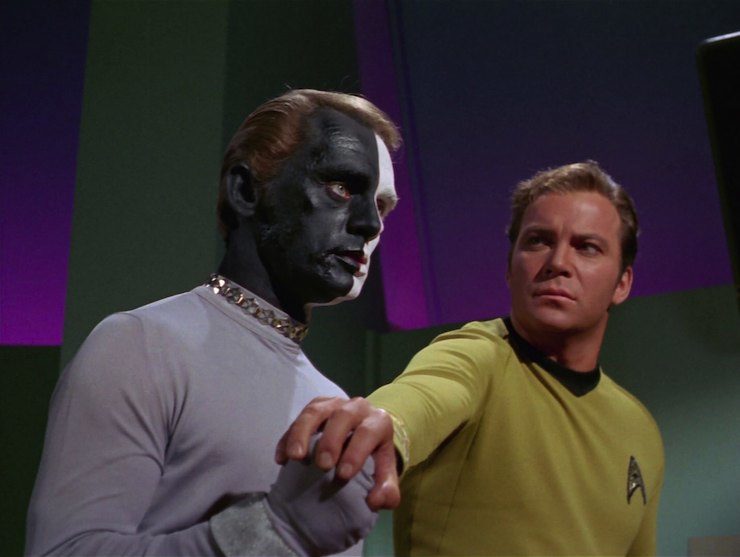
Kirk also points out that there is no extradition treaty between the Federation and Cheron. The best he can offer to Bele—who wants the Enterprise to go to Cheron immediately—or Lokai—who wants asylum—is to take them both to Starbase 4 and let the authorities there deal with them.
After Bele is sent to his guest quarters, Chekov reports that the ship has changed course. Scotty can’t regain control. Kirk calls red alert, while Lokai leaves sickbay. Bele appears on the bridge and announces that he has mental control of the ship. He has been chasing Lokai for 50,000 years, and he won’t wait any longer.
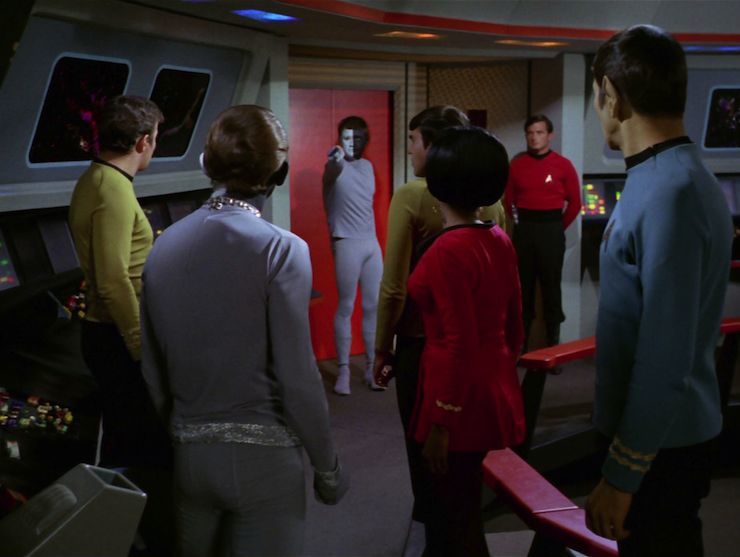
Lokai comes to the bridge and begs for sanctuary, with Bele making snide commentary about how he always finds fools to help him. Kirk tries to put them into custody, but they’re both protected by personal force fields, apparently.
So Kirk has one last card to play: he’ll destroy the ship. Bele insists he’s bluffing, so Kirk starts the self-destruct sequence. Bele holds out until the last second and then Kirk aborts the sequence and Bele returns control to Kirk. The ship heads to Ariannus.
Kirk doesn’t put them in the brig, and he encourages the pair of them to learn about the Federation from some of its finest representatives.
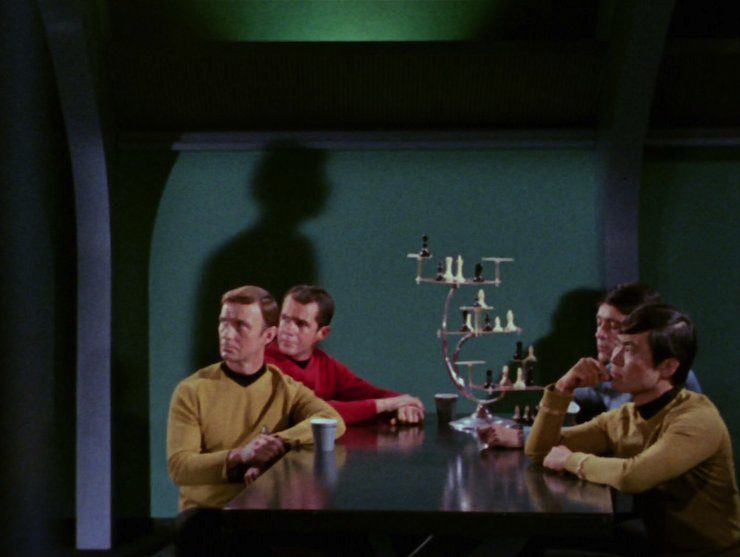
Lokai takes advantage, talking to some of the crew in the rec room, telling them of the oppression he lived under. For Bele’s part, Starfleet denies his request to take Lokai to Cheron immediately—there must be a hearing, in lieu of any extradition treaty between the two governments. Bele is also appalled to realize that the crew don’t understand the significance of the difference between him and Lokai: the side of the body that is black is different. To Bele, that’s everything, whereas to the Starfleet officers, it’s an irrelevant difference.
The ship arrives at Ariannus. Scotty supervises the decontamination procedure, and then Kirk orders the ship to head for Starbase 4. Kirk invites Bele to the bridge, where it’s revealed that he has burned out navigation and the self-destruct. The ship is back under Bele’s control. Lokai shows up and the two of them shout at each other and then attack. They struggle, even as Kirk tries to convince them that fighting will just end their battle prematurely.
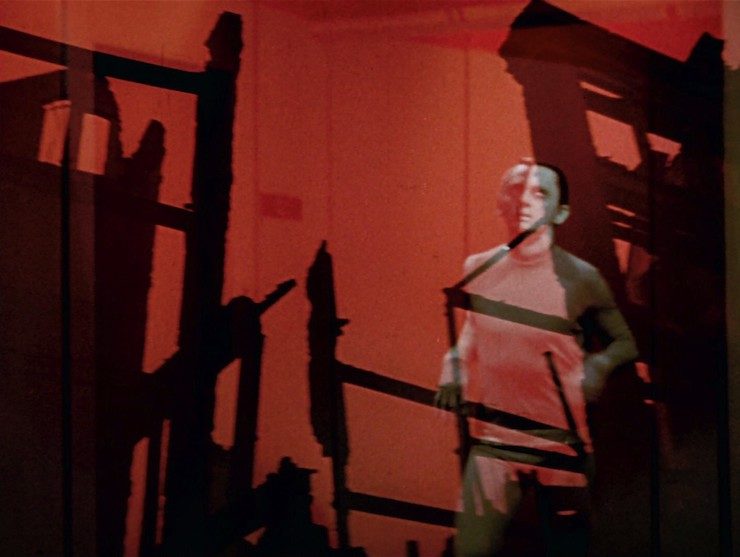
However, they’re almost to Cheron in any case, so Kirk proceeds the rest of the way there. Spock’s scan reveals cities, a system of roads, and lower animal life and plant life, but no sapient life. There are lots of corpses, though. Bele and Lokai are devastated to realize that the hate their people had for each other led to genocide. First Lokai leaves the bridge, then Bele chases him. They chase each other through the corridors for what seems like days before Lokai makes it to the transporter room and beams himself down. Bele follows.
Leaving them to kill each other, Kirk has Sulu set course to Starbase 4.
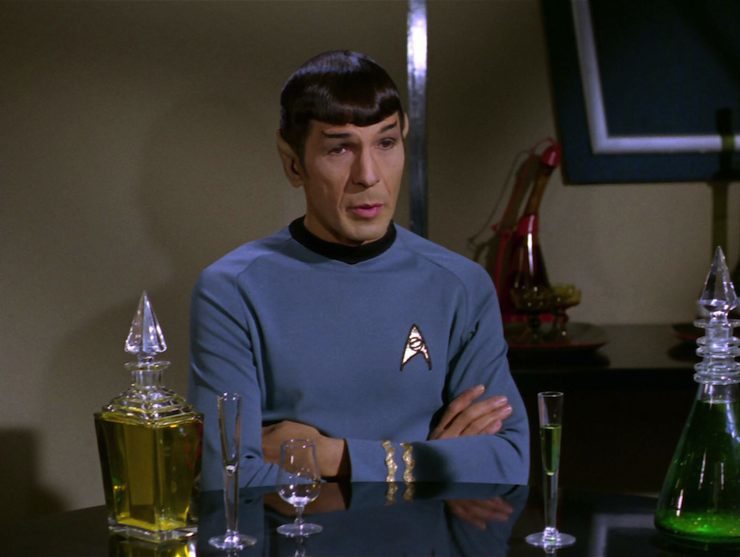
Fascinating. Spock gives Bele a bit of Vulcan history, consistent with what we’ve been told, primarily in “Balance of Terror“: Vulcans used to be savage and warlike, in much the same way the Cherons are, but they saved themselves by embracing logic.
I’m a doctor not an escalator. McCoy absolutely is sure that the odd pigmentation of Lokai is a one-of-a-kind genetic mutation that couldn’t possibly be a normal thing. Spock concurs. They are proven 100% wrong when Bele shows up and it’s discovered that there’s a whole planet of these folks. Oops.
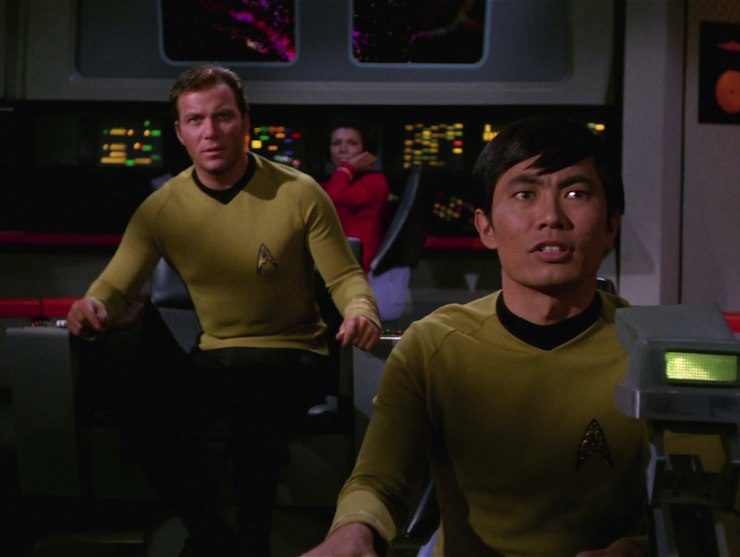
Ahead warp one, aye. Sulu, along with Chekov, talks about racial prejudice as an abstract and outdated concept from the 20th century on Earth. At the end, he wonders what they have left to fight for.
It’s a Russian invention. Chekov gets to report every time something goes horribly wrong with the ship. Sucks to be the ensign.
Hailing frequencies open. Uhura does her usual thing of passing on messages and hailing people and stuff.
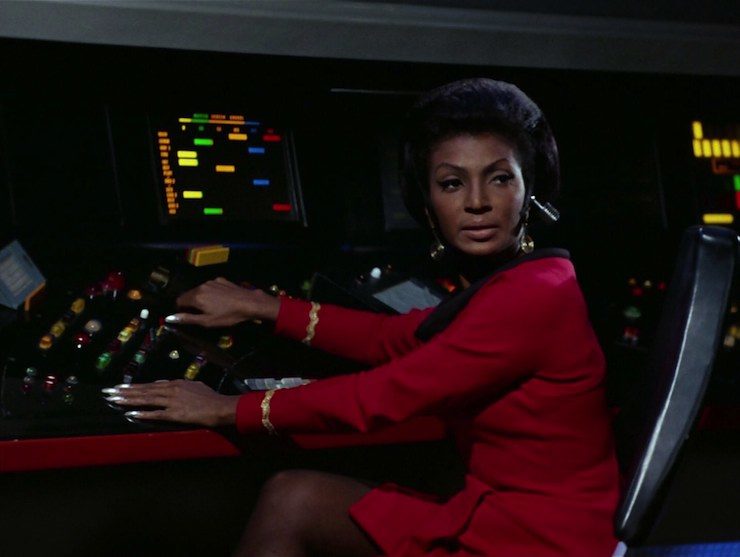
I cannot change the laws of physics! Scotty is surprisingly quiet on the subject of destroying the ship, calmly giving his code along with Kirk and Spock.
Channel open. “All that matters to them is their hate.”
“Do you suppose that’s all they ever had, sir?”
“No, but that’s all they have left.”
Spock, Uhura, and Kirk delivering the moral of the episode.
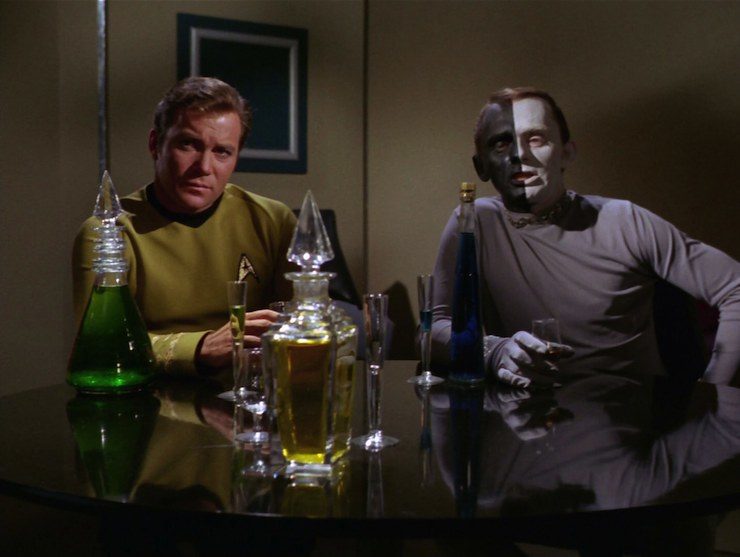
Welcome aboard. Having had Catwoman last week, this week we get the Riddler! Frank Gorshin, who is definitely best known for his role as the Riddler on the Batman TV series and its attendant movie, plays Bele. Lou Antonio plays Lokai, while recurring regulars James Doohan, Nichelle Nichols, George Takei, Walter Koenig, and Majel Barrett are all here as well.
Trivial matters: The sequence for the Enterprise self-destruct was repeated almost identically in Star Trek III: The Search for Spock, only in the movie, the sequence was completed.
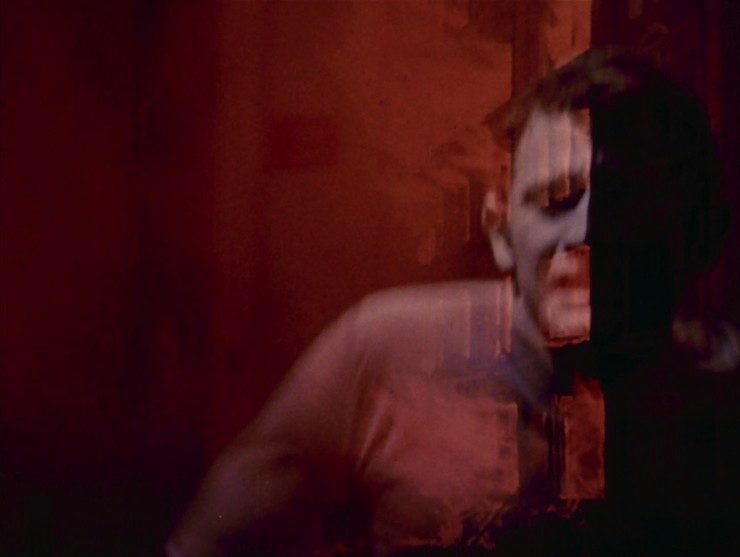
The footage superimposed over Bele and Lokai running through the Enterprise corridors was stock footage of cities burning in Europe after aerial assaults during World War II.
The zooming in and out on the red alert signal, with the camera at a tilt, was allegedly an homage to Gorshin’s more famous role as the Riddler, as that kind of goofy camerawork was a hallmark of Batman.
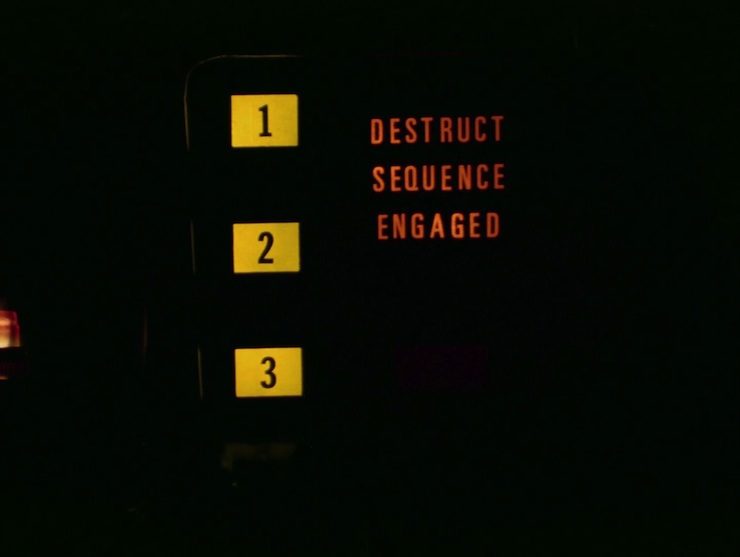
Gene Coon’s outline was originally written in 1966 for the first season, but it was never used. By this stage of the third season, they were using any old crap lying around the office, so they dusted this one off and gave it to Oliver Crawford to write a teleplay based on it. As with all of Coon’s third-season work—of which this is his last—it’s under his “Lee Cronin” pseudonym.
The Romulan War novels by Michael A. Martin established that a battle took place on Cheron during the titular conflict, which was referenced by Admiral Jarok in TNG‘s “The Defector,” though if it was the site of a battle during the Romulan War, Kirk wouldn’t have described it as being in an uncharted region…
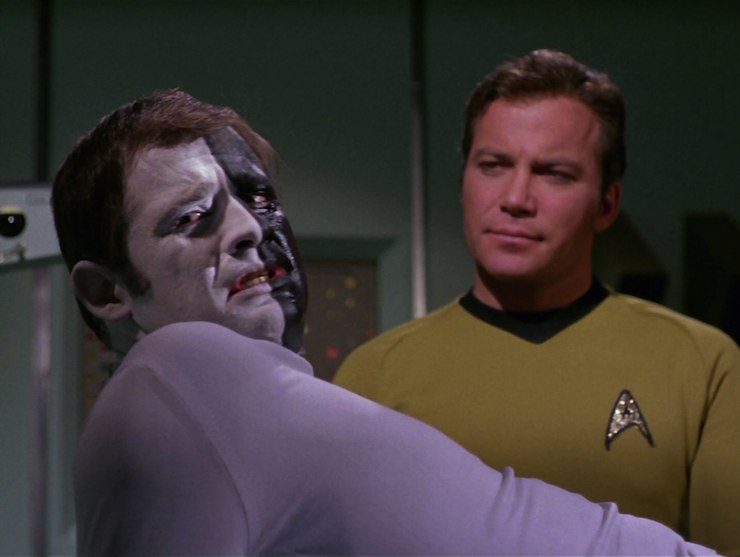
Greg Cox established in his novel No Time Like the Past that Bele and Lokai continued their conflict on Cheron, even though they were the only ones left.
To boldly go. “It doesn’t make any sense!” Whenever people write articles about how Star Trek did social commentary, this episode always comes up as a popular example of how brilliant they were at it.
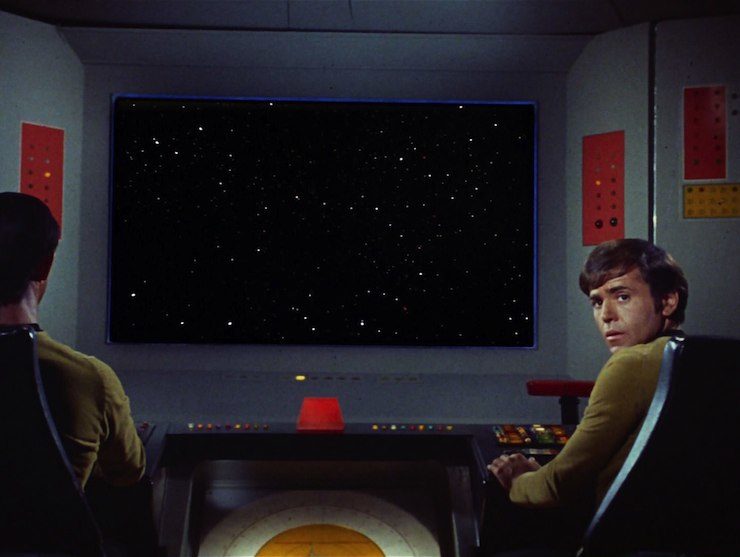
And every time I read one of those articles, my teeth hurt, because this episode is just awful.
The basic message is a good one. I love the total confusion on Kirk and Spock’s face when Bele explains that Lokai is so obviously inferior because of which side of his face has the white and black pigmentation.
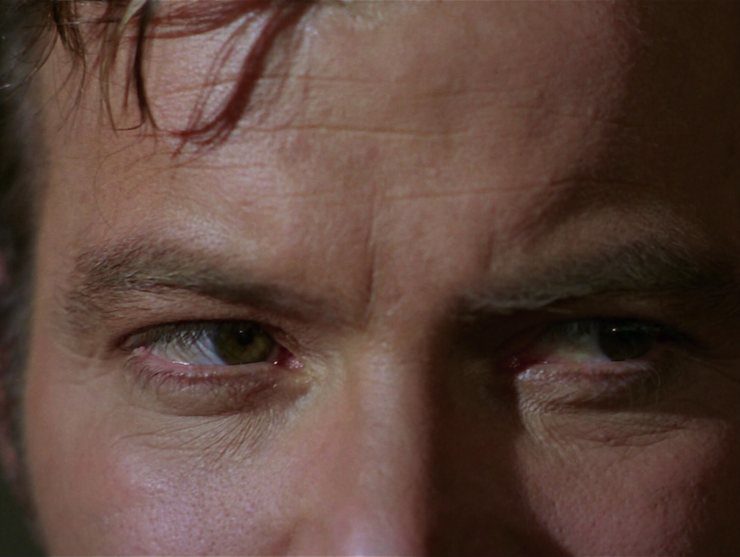
But that is all this slog of an episode has going for it. There’s only about fifteen minutes of story here, and it’s endlessly stretched out to an hour. Countless reaction shots as the crew wonders where the invisible ship is. Countless reaction shots as they realize the Enterprise is out of control. Simply endless closeups (including a bizarre fetish for closeups of eyes and mouths during the self-destruct sequence). Long drawn-out closeup reaction shots when Bele takes over the ship a second time. The spectacularly uninteresting decontamination procedure on Ariannus, which has absolutely nothing to do with the plot and should have happened between scenes, but no, we have to suffer through this simple procedure that goes off without a hitch because we need to fill time.
And then the final indignity, being forced to watch simply endless shots of Bele and Lokai running through corridors. And running through corridors. And then running through more corridors. And then, for good measure, running through yet still more corridors.
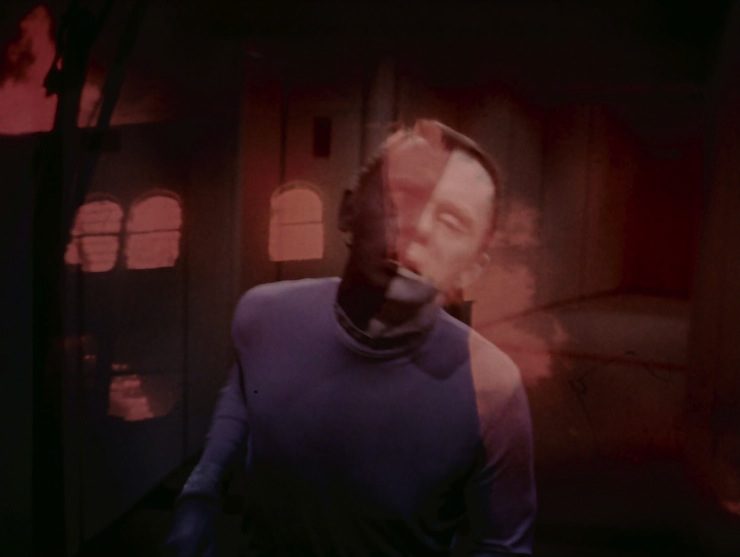
All wrapped around a plot that has the subtlety of a nuclear explosion, with the cherry on top being the sledgehammery bit in the rec room where Chekov and Sulu talk about the bad ol’ 20th century with its yucky racial prejudice, and thank God we don’t have that nonsense anymore. (And I’m just wondering where Stiles from “Balance of Terror” fits in…)
Okay, the episode has one other thing going for it: no one ever went wrong casting Frank Gorshin in anything, and he does a fantastic job as the hardliner Bele. An aggressively nasty turn, done in only by the doofy manner in which Gorshin runs through the corridors (which he does a lot, did I mention that?) at the end.
Warp factor rating: 3
Next week: “Whom Gods Destroy”
Keith R.A. DeCandido will be curating a special New York Review of Science Fiction event at the Brooklyn Commons, celebrating the 50th anniversary of Star Trek, featuring authors Steven Barnes and David Mack, as well as Tor.com’s own Emmet Asher-Perrin. It will take place Thursday the 8th of September—the actual 50th anniversary—at 7pm.










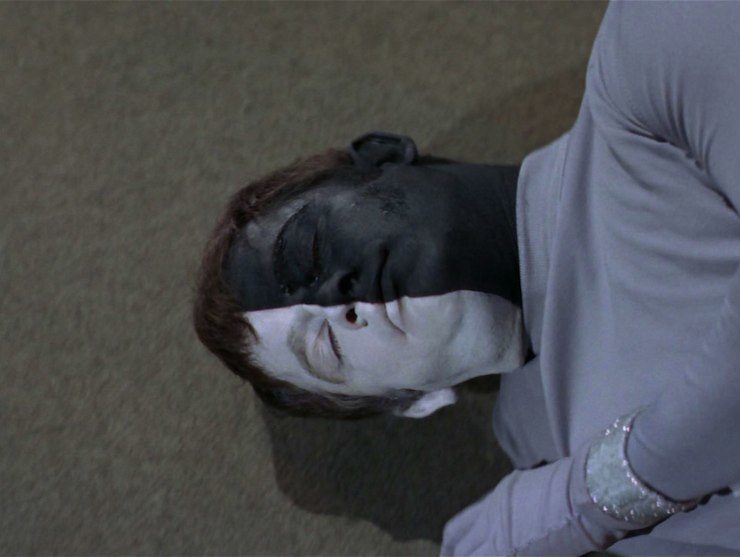
This is the only original series episode I can remember watching as a kid. I remember thinking it was really, really good, despite the goofy running. I’m not sure if that was mentioned in the recap. I probably thought that because I was quite familiar with Batman and loved that The Riddler was in this episode.
I’ll be interested to see what I think of it now once I rewatch it after all these years.
When I read these, I save up comments in my head. Except now I’ve completely forgotten what I was going to say, because your Swiftian tag in the comments threw me off completely. Always read the tags.
But really, the episode is terrible. The cinematography alone is just bizarre and fairly unusual for TOS. The plot might make an okay B-plot, not an entire episode. The only scene I like is the classic one, Bele explaining the difference between his and Lokai’s groups. The rest of it…yawn.
There are people who think this is an example of how Star Trek is brilliant at social commentary? Good grief. The only way this episode could have been more heavy-handed is if there had been a big “Racism Is Bad” musical number at the end.
While it goes unmentioned in the recap, there’s a very long/goofy running sequence through some corridoors. Perhaps rather than one guy chasing Lokai for 50,000 years, they should have sent two guys. Had someone been available to run in the opposite direction and intercept him, they probably could have cut that down to 10,000 years. 20,000 tops.
I can’t agree that the message of the episode is a good one. Yes, certainly the part where they highlight the silliness of racism is something we can all get behind, but it doesn’t stop there. They have to go on and show that Bele and Lokai are equally wrongheaded. In the context of the period, the point of the episode is pretty clearly, “George Wallace and Malcolm X are equally bad!” Which is BS. The episode is preaching equality out one side of its mouth while saying, “But you shouldn’t do anything too provocative to achieve equality.” If the episode were made today, you know it’d be critical of Black Lives Matters for being too belligerent.
As I observed some weeks back, I think the third season deserves some credit for trying to embrace ST’s moral/philosophical dimension perhaps better than the second season sometimes did, but it did tend to fumble the execution. This episode is a classic example. The idea of an allegory about racism is noble, but it’s just so damn heavy-handed that it’s hard to take seriously — and casting white actors in both roles didn’t help much. There’s also so much that’s ridiculous about the Cheronians. The idea of the two sides of the body being pigmented differently isn’t entirely out of the realm of possibility, given the way bilateral development happens (I’ve seen some cats that had “Two-Face” fur coloring to an extent, and of course there are the heterochromatic ones with two different eye colors), but it just looked so blatantly like pancake makeup and wasn’t remotely convincing. It would’ve been better if the makeup had been less obvious, if there’d been a bit of gradation in the middle instead of a sharp divide, and if it had included the hair as well as the skin (since, really, why wouldn’t it include the hair?) Plus, if they belonged to such mutually opposed cultures, why were they wearing the same outfit? (An outfit that conveniently includes gloves so the actors’ hands didn’t have to be made up.)
Also, this episode has a fault that was also common in the Fred Freiberger-produced episodes of Space: 1999 — giving the guest aliens a grab-bag assortment of nigh-magical superpowers. They’re immortal, they’re telekinetic, they have built-in deflector shields, they emit deadly heat when they fight… it’s just absurd. Did they need to be 50,000 years old? Maybe it would’ve been better if they were just the last survivors of two races that had been warring for 50,000 years. That would’ve made more sense, because if Spock detected bodies on Cheron, then the final collapse of their civilization must’ve happened no more than a few years before, maybe just months before, assuming most of those bodies were exposed to the elements. There’s no way the bodies of so many war casualties would survive for thousands of years. And getting home just months or a few years too late after a 50-millennium chase would be absurdly coincidental. And there could’ve been a better way for them to endanger the ship than telekinesis. What if they’d actually managed to convince some of the crew to take sides and help them?
And why the invisible ship? Why not just use stock footage of the blob-of-light ship from “Friday’s Child” or “Journey to Babel”? It took up so much time and was so totally pointless, and it ended up being just one more random super-ability out of the grab bag.
Meanwhile… How do you “decontaminate” a planetary bacterial infection… from orbit? Whether it’s a chemical or a biological agent, the intense radiation in space and the upper atmosphere would probably destroy it before it reached the ground. And there’s no way one starship would be able to hold a large enough quantity of the stuff to pervade an entire planet’s ecosystem. Not to mention the risk of killing more beneficial organisms in the process, like that recent anti-Zika mosquito spraying that accidentally killed a bunch of honeybees. Wouldn’t it have made more sense just to beam down a supply of medicine?
The self-destruct sequence is okay, reasonably suspenseful. The part I’ve always had a problem with was the reuse of the exact same sequence in The Search for Spock. Sure, it’s nostalgic and all, but are we supposed to believe that military personnel would keep the same passwords for 15 years? Heck, they should’ve changed the passwords as soon as they were used here. That’s basic security. It always annoyed me that TSFS put Easter-egg familiarity above common sense. It would’ve been better if they’d used the same structure for the sequence but changed the actual codes.
@5/Sean: You’re quite right. I had the same thought, that it suggested too much of a equivalency between the oppressors and the oppressed.
On a personal note, we’re all moved into our place. We’re not all unpacked yet — I haven’t even gotten my desk set up in my office yet, though that should be happening tomorrow — and the place is decorated in Early High Box, but at least we’re in. (It took forever to get everything out of the old place…..) The Rewatches should be back to (ab)normal going forward.
—Keith R.A. DeCandido
I’m not sure if I’ve heard this episode called “brilliant” but I’ve seen it as a counterpoint to the argument that anvilicious social justice messaging is some new thing that’s ruining SF.
I never, ever had a problem with the endless running through corridors, of this episode. I thought, and thought again when I rewatched last year, that for the emotional impact, it was perfectly paced — especially since both actors played the scene as exhausted, barely staying on their feet. I know I am in the minority (ha) on this.
@5/Sean – Yeah, this occurred to me, too, even though I myself recently recommended this episode as an example of Trek’s social commentary. It would have to be written far differently today. Being “color blind” in the sense this episode endorses can only be done by the privileged.
@6/Christopher – Heck, they should’ve changed the passwords as soon as they were used here. That’s basic security. It always annoyed me that TSFS put Easter-egg familiarity above common sense. Well, while it’s hard to argue that your point is sound, I think nostalgia is an okay defense since TSFS is full of nostalgia, from the tribbles in the bar to the casting of Mark Lenard. Maybe the codes aren’t so much the thing as the voice recognition (although I know that’s not stated on screen) – so no need for constantly changing passwords, so long as the right voices are speaking them. (Do I get a No-Prize?)